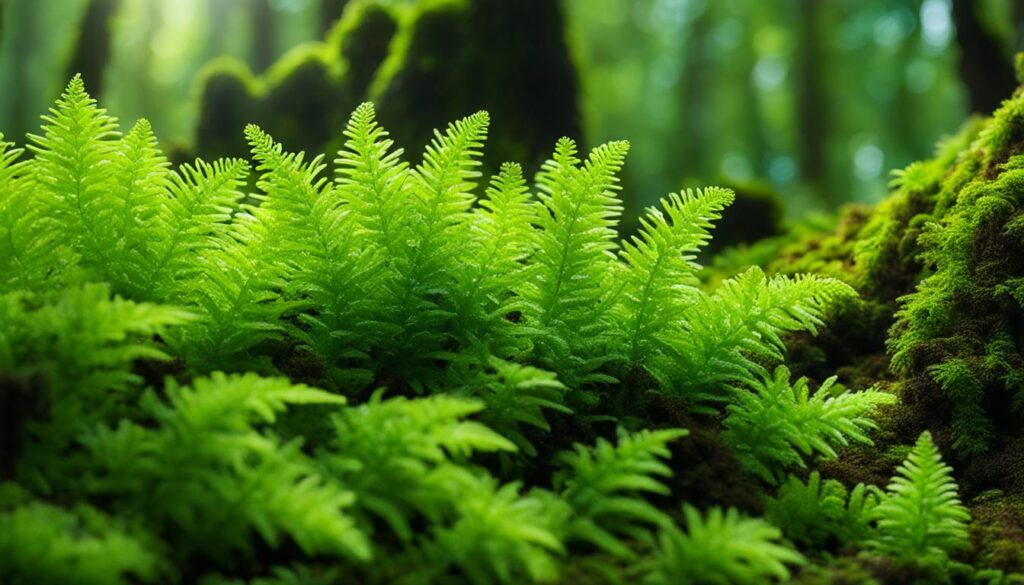Selaginella kraussiana, also known as Krauss’s Spikemoss, is a versatile and low-maintenance plant that serves as an excellent ground cover option. This spikemoss plant, belonging to the Selaginella species, features a unique lacy leaf structure and is ideal for both indoor and outdoor settings. It is native to parts of Sub-Saharan Africa and Macaronesia, where it thrives in terrestrial habitats.
Table of Contents
ToggleKey Takeaways:
- Selaginella kraussiana, also known as Krauss’s Spikemoss, is a low-growing ground cover plant.
- It is a popular choice for indoor and outdoor settings due to its unique lacy leaf structure.
- This plant is native to parts of Sub-Saharan Africa and Macaronesia and is not a true fern, but a member of the clubmoss family.
- Selaginella kraussiana is classified as a vascular plant in the family Selaginellaceae, belonging to the division of non-seed vascular plants.
- It is commonly used for container planting, thrives in terrariums, and provides lush greenery and texture to outdoor spaces.
Classification and Characteristics
Selaginella kraussiana, also known as Krauss’s Spikemoss, belongs to the division of non-seed vascular plants, specifically lycophytes, and is classified as a vascular plant in the family Selaginellaceae. This unique plant is a creeper with a perennial lifespan and obtains nutrients through autotrophic mode of nutrition.
Native to South Africa, Selaginella kraussiana thrives in terrestrial habitats. It prefers tropical and sub-tropical/monsoonal climate zones, making it well-suited to certain regions.
| Plant Division | Plant Growth Form | Autotrophic or Heterotrophic? | Native Distribution | Preferred Climate Zone |
|---|---|---|---|---|
| Non-seed vascular plants (Lycophytes) | Creeper | Autotrophic | South Africa | Tropical and sub-tropical/monsoonal |
Landscaping Features
Selaginella kraussiana, commonly known as Krauss’s Spikemoss, possesses a range of desirable plant features that make it a favorite choice among landscapers. This unique plant boasts ornamental foliage and a distinctive growth form, ensuring it adds visual interest and beauty to any space.
One of the standout characteristics of Selaginella kraussiana is its stunning ornamental foliage. The delicate, lacy leaves of this plant create an intricate texture that enhances the overall aesthetic appeal of gardens and landscapes. The foliage is typically a vibrant green color, adding a burst of life and freshness to its surroundings.
In addition to its foliage, Selaginella kraussiana’s growth form is highly valued for its ornamental qualities. This plant has a low-growing habit, making it an ideal choice for ground cover. Its dense mat-like growth provides lush, green coverage that softens the look of bare soil and creates a visually pleasing carpet of foliage.
The versatile nature of Selaginella kraussiana allows it to be used in a variety of landscape settings. It is often utilized for container planting, bringing a touch of natural beauty to outdoor patios, balconies, and indoor spaces. Its ability to thrive in terrariums further expands its usability, adding a touch of elegance to these enclosed environments.
As a ground cover, Selaginella kraussiana excels in adding texture and color to outdoor landscapes. Its low-growing form fills in gaps and crevices effectively, preventing soil erosion and enhancing the overall visual appeal of gardens, pathways, and rockeries.
Landscaping Uses of Selaginella kraussiana
The desirable features of Selaginella kraussiana make it a versatile plant for various landscaping uses and applications. Here are some common applications for this spikemoss:
- Ground cover in gardens and landscapes
- Container planting for patios, balconies, and indoor spaces
- Adding lushness and texture to rockeries
- Softening pathways and borders
- Providing greenery and visual interest in terrariums
Whether utilized as a ground cover, container plant, or terrarium addition, Selaginella kraussiana is a versatile and visually captivating choice for enhancing the landscape.
Plant Care and Propagation
Proper care and propagation methods are essential for the successful growth and propagation of Selaginella kraussiana. By understanding its light and water preferences, rootzone tolerance, and propagation techniques, you can ensure the health and vitality of this versatile plant.
Light Preference
Selaginella kraussiana thrives in partial to full shade, making it an ideal choice for areas with low light conditions. It prefers indirect sunlight or filtered light, as direct sunlight can scorch its delicate foliage. Placing it near a north-facing window or in areas with dappled shade will provide the optimal light conditions for this plant.
Water Preference
When it comes to watering Selaginella kraussiana, it has a moderate water preference. It is important to keep the soil consistently moist but not waterlogged. Regular watering, allowing the top inch of soil to dry between waterings, is recommended. Avoid overwatering, as this can lead to root rot and other fungal diseases.
Rootzone Tolerance
Selaginella kraussiana has good rootzone tolerance and can tolerate moist soils with good drainage. It is crucial to provide well-draining potting mix or soil to prevent waterlogging and root rot. Ensuring proper drainage will help maintain a healthy root system and overall plant vigor.
Propagation Method
Propagating Selaginella kraussiana is relatively straightforward and can be done through stem cuttings or division.
- Stem Cuttings: Take stem cuttings with several nodes using a clean, sharp knife or scissors. Remove the lower leaves, leaving a few at the top. Dip the cut end in a rooting hormone if desired, and plant the cutting in a well-draining potting mix. Keep the soil consistently moist and provide indirect light. The cutting should root within a few weeks, and new growth will appear.
- Division: To divide the plant, carefully separate the clumps or sections by gently pulling them apart. Each section should have its own root system and adequate foliage. Replant each section in fresh soil, ensuring that it is well-draining. Water the divisions thoroughly and provide the appropriate light conditions. New growth will emerge from each divided section.
By following these propagation methods and providing the necessary care, you can easily expand your collection of Selaginella kraussiana and enjoy its striking foliage in various areas of your home or garden.
Foliar
Selaginella kraussiana is an evergreen plant, meaning it retains its foliage throughout the year. This characteristic makes it an excellent choice for adding year-round greenery to various spaces. The mature foliage of Selaginella kraussiana is typically green in color, adding a vibrant touch to its surroundings.
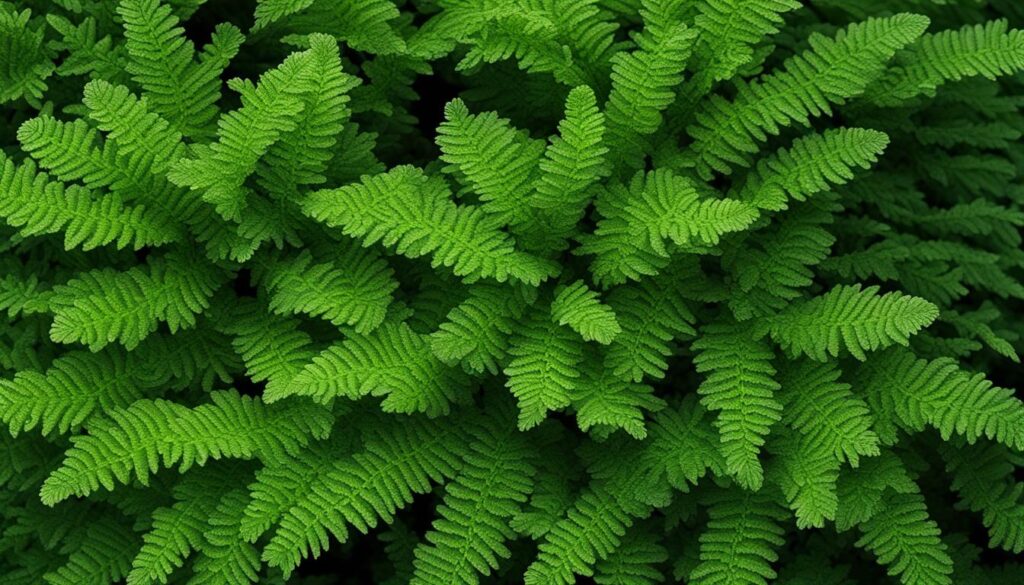
The foliage of Selaginella kraussiana is one of its most appealing features. The leaves are delicate and intricate, with a lacy appearance that creates a visually stunning effect. The green color of the mature foliage provides a lush and natural feel to gardens, terrariums, and indoor plant arrangements.
The foliage of Selaginella kraussiana not only enhances the beauty of its surroundings but also contributes to its overall health. The leaves play a vital role in photosynthesis, absorbing sunlight and converting it into energy for the plant’s growth and development. Additionally, the dense foliage helps to retain moisture, keeping the plant well-hydrated and resilient.
Distribution
Selaginella kraussiana, also known as Krauss’s Spikemoss, has a native distribution in the Macaronesia region and parts of South and East Africa. This plant is naturally found in these areas, where it thrives in its native habitat.
However, Selaginella kraussiana has also been introduced to other regions around the world. One such region is the Azores, where its presence was initially controversial but later confirmed through fossil evidence. This indicates that the plant has successfully established itself in the Azores.
In addition to the Azores, Selaginella kraussiana has also been introduced to places like New Zealand and Australia. However, in these regions, it is considered an invasive species. The spikemoss has the ability to form dense mats in shaded areas, displacing native plant species.
Here is a visual representation of Selaginella kraussiana’s distribution:
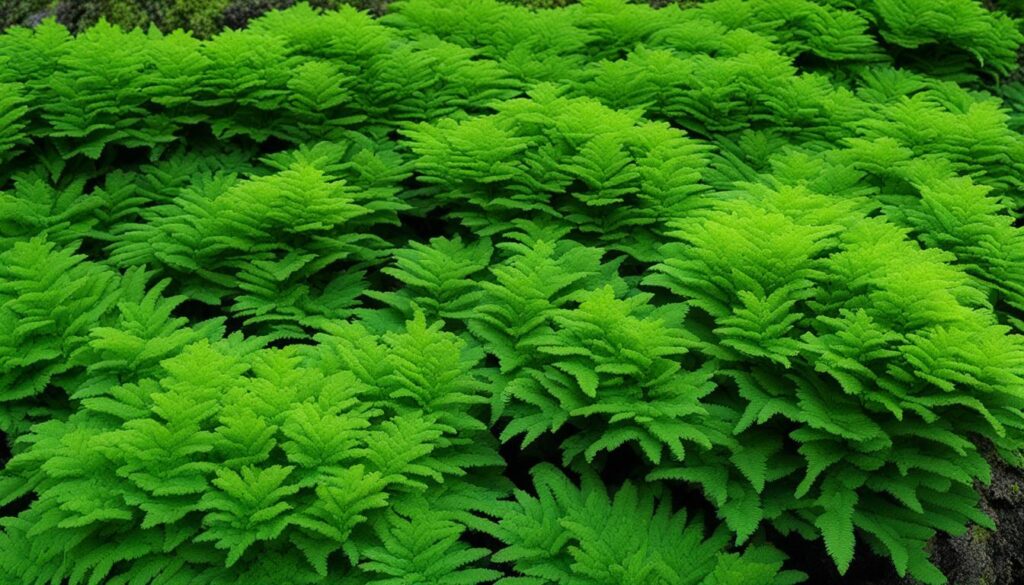
Distribution of Selaginella kraussiana
| Region | Status |
|---|---|
| Macaronesia | Native |
| South Africa | Native |
| East Africa | Native |
| Azores | Introduced |
| New Zealand | Invasive |
| Australia | Invasive |
As seen in the table, Selaginella kraussiana’s native distribution spans Macaronesia, South Africa, and East Africa. However, it has also been introduced to new regions like the Azores, where it has achieved a confirmed presence. Invasive populations can be found in New Zealand and Australia, where the plant poses a threat to native ecosystems.
Cultivation
Selaginella kraussiana is commonly cultivated for ornamental purposes. As a houseplant, it adds a touch of natural beauty and greenery to any indoor space. This versatile plant is also well-suited for outdoor cultivation in temperate regions where it can be grown as a ground cover or incorporated into landscape designs.
To ensure the best growth and health of Selaginella kraussiana, it is important to provide the preferred conditions for this plant. Keep in mind the following factors:
- Temperature Requirement: Selaginella kraussiana thrives in temperatures ranging from 5°C (41°F) to 30°C (86°F). It prefers a temperate climate and can tolerate both cool and warm conditions.
- Light Preference: This houseplant prefers a sheltered spot with full or partial shade. It can tolerate low light conditions, making it an excellent choice for areas with limited natural light.
- Watering Needs: Selaginella kraussiana requires consistently moist soil. It is important to water it regularly, ensuring the root zone remains adequately hydrated. Avoid overwatering, as it can lead to root rot.
- Soil Preference: This plant thrives in well-draining potting media that retains humidity without becoming overly wet. A mix of peat moss, perlite, and organic matter can provide the ideal growing medium.
There are several popular cultivars of Selaginella kraussiana that are sought after for their unique characteristics:
| Cultivar | Description |
|---|---|
| Brownii | A cultivar recognized by the Royal Horticultural Society, known for its bronze-tinted foliage. |
| Aurea | A cultivar with golden-yellow foliage, adding a vibrant touch to any indoor or outdoor setting. |
| Gold Tips | This cultivar features green foliage with golden tips, providing a subtle contrast and visual interest. |
Overall, Selaginella kraussiana is a resilient and visually appealing plant that can thrive in a variety of conditions. By providing the preferred temperature, light, water, and soil conditions, along with choosing the right cultivar, you can successfully cultivate this plant for its ornamental purposes.
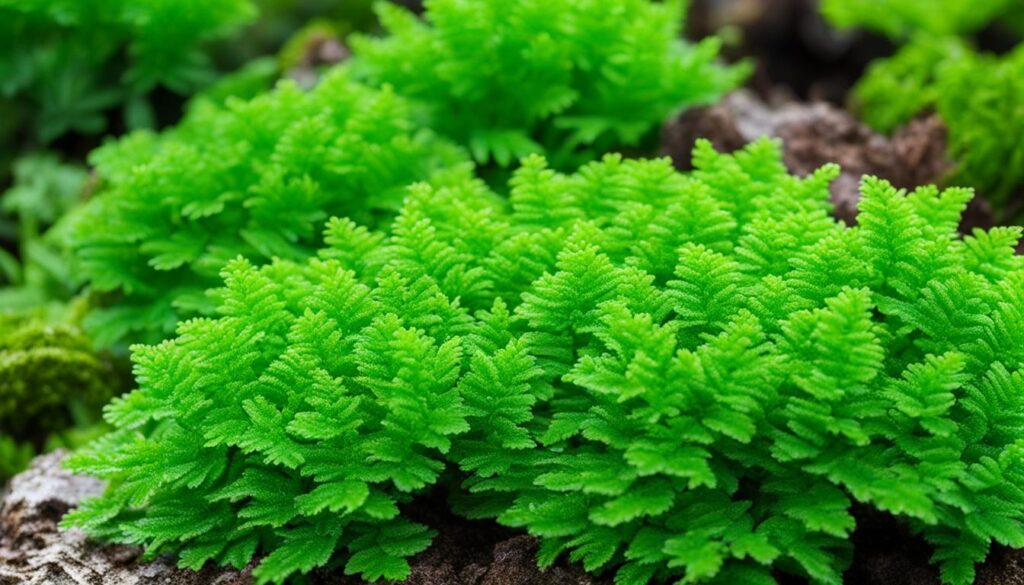
Winter Care and Varieties
During the winter, it’s important to provide proper care for your Selaginella kraussiana, also known as Krauss’s Spikemoss. Additionally, understanding the different varieties available, such as the popular ‘Frosty Fern’ and Selaginella martensii, can help you make informed decisions regarding their care and maintenance.
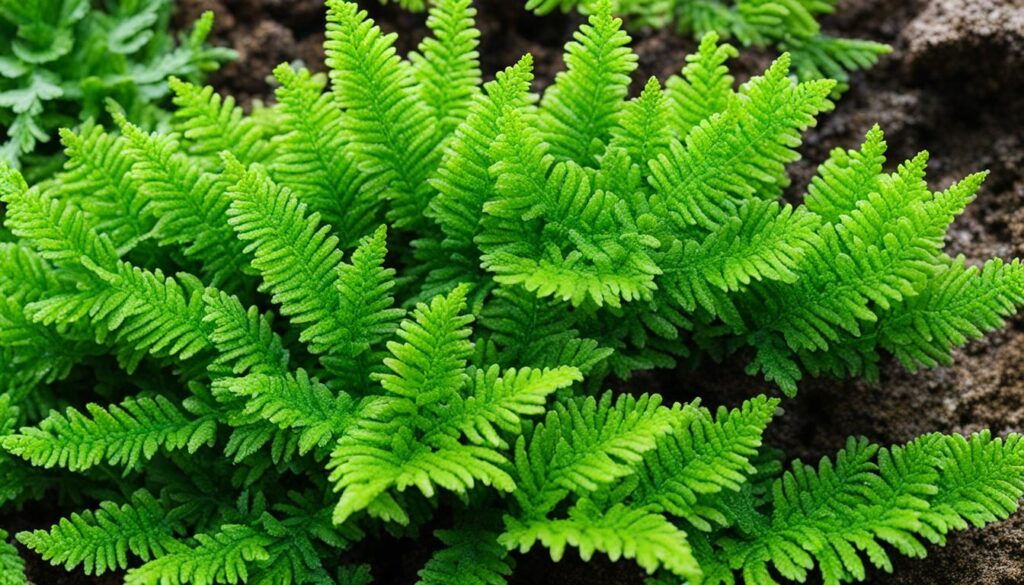
Cultivar Spotlight: ‘Frosty Fern’ and Selaginella martensii
One of the cultivars of Selaginella kraussiana often sold as a houseplant during winter is the ‘Frosty Fern.’ However, it’s important to note that the ‘Frosty Fern’ commonly available in the market is actually the taller-growing variety called Selaginella martensii, rather than the creeping S. kraussiana.
This distinction is important because the creeping Selaginella kraussiana typically requires different care than Selaginella martensii. To ensure the well-being of your plant, it’s essential to differentiate between these two varieties and follow the appropriate winter care guidelines.
Winter Care Tips for Selaginella kraussiana
When caring for Selaginella kraussiana during the winter months, consider the following:
- Provide adequate humidity: Selaginella kraussiana thrives in high humidity environments. Consider using a humidifier or placing a tray with water near the plant to maintain moisture levels.
- Avoid temperature extremes: Keep the plant away from cold drafts and ensure it remains in a temperature range of 50-75°F (10-24°C). Avoid placing it near heaters or vents that can cause temperature fluctuations.
- Provide filtered light: While Selaginella kraussiana prefers bright, indirect light, it’s crucial to protect it from harsh direct sunlight during winter. Position the plant near a window with filtered light or use a sheer curtain to diffuse the sunlight.
- Watering: Monitor the moisture level of the soil and water the plant when the top inch of soil feels dry. Avoid overwatering to prevent root rot.
Comparison of Selaginella kraussiana and Selaginella martensii
To help differentiate between the varieties, here is a comparative overview of Selaginella kraussiana and Selaginella martensii:
| Selaginella kraussiana | Selaginella martensii |
|---|---|
| Creeping growth habit | Taller growth habit |
| Low-maintenance ground cover option | Suitable for container gardening or as a houseplant |
| Requires partial to full shade | Thrives in bright, indirect light |
| Moist, well-draining soil preference | Requires well-draining soil |
Understanding the differences between these varieties will help you provide tailored care to ensure the health and vitality of your Selaginella plants during the winter season.
Pests and Common Issues
While Selaginella kraussiana is generally not prone to many pests or issues, there are a few common problems that you may encounter when caring for this plant.
1. Root Rot
Root rot can occur if the plant is kept in excessively wet conditions, usually due to overwatering. It is important to ensure that the soil has good drainage to prevent water from sitting around the roots for prolonged periods. To prevent root rot, allow the soil to dry out between waterings and avoid overwatering.
2. Browning Tips
If you notice browning tips on the fronds of Selaginella kraussiana, it could be a sign of inadequate watering or dry conditions. This plant prefers moderate moisture, so make sure to water it regularly but avoid keeping the soil overly dry or saturated.
3. Sunburn
Selaginella kraussiana is adapted to thrive in partial to full shade, so if the plant is exposed to direct sunlight for extended periods, it can suffer from sunburn. To prevent sunburn, place the plant in a shaded area or use a sheer curtain to filter the sunlight.
4. Wilting Fronds
Wilting fronds, especially if they are turning yellow, may indicate root rot. If you notice wilting fronds, allow the plant to dry out fully before watering again. This will help prevent further damage and promote root health.
In the next section, we will explore the winter care and different varieties of Selaginella kraussiana.
Conclusion
Selaginella kraussiana, commonly known as Krauss’s Spikemoss, is a remarkable plant that offers numerous benefits as a low-maintenance ground cover option, both indoors and outdoors. With its unique foliage and easy-care nature, it has become a popular choice for adding greenery to various spaces.
As a versatile plant, Selaginella kraussiana can thrive in a range of environments, making it suitable for both indoor and outdoor settings. Whether you want to enhance the aesthetic appeal of your garden or create an inviting indoor oasis, this plant ticks all the boxes.
One of the key advantages of Selaginella kraussiana is its low-maintenance requirements. This plant is known for its ability to withstand different lighting conditions, from partial shade to full shade, making it ideal for areas with limited sunlight. Additionally, it is relatively tolerant of moderate watering and exhibits good rootzone tolerance, reducing the risk of overwatering or root rot.
With its ability to create dense mats and spread quickly, Selaginella kraussiana makes an excellent ground cover, lending a lush and vibrant appearance to your outdoor spaces. In addition, its compact growth habit and ornamental foliage make it a visually appealing option for indoor potted plants and terrariums.
FAQ
What is Selaginella kraussiana?
Selaginella kraussiana, also known as Krauss’s Spikemoss, is a low-growing, mat-forming evergreen perennial that belongs to the Selaginella species.
Is Selaginella kraussiana a fern?
No, despite its common name, Selaginella kraussiana is not a true fern. It belongs to the ancient lineage of plants known as clubmosses.
What are the landscaping features of Selaginella kraussiana?
Selaginella kraussiana has ornamental foliage and a unique growth form that adds visual interest to any space. It is often used for container planting and as ground cover in outdoor spaces.
Where does Selaginella kraussiana thrive?
Selaginella kraussiana thrives in partial to full shade and prefers moderate water and moist soils with good drainage. It is native to parts of Sub-Saharan Africa and Macaronesia.
How can Selaginella kraussiana be propagated?
Selaginella kraussiana can be propagated through stem cuttings or division. Stem cuttings can be rooted in a well-draining potting mix, while division involves separating the plant into smaller sections and replanting them in fresh soil.
What color is the foliage of Selaginella kraussiana?
The mature foliage of Selaginella kraussiana is typically green in color.
Where is Selaginella kraussiana naturally found?
Selaginella kraussiana is native to parts of South and East Africa as well as the Macaronesia region. It has also been introduced to other regions and is considered an invasive species in some areas.
How is Selaginella kraussiana cultivated?
Selaginella kraussiana is commonly cultivated for ornamental purposes. It requires a minimum temperature of 5°C (41°F) and is often grown as a houseplant in temperate regions. It prefers a sheltered spot in full or partial shade and acidic to neutral pH levels.
What is ‘Frosty Fern’ and how does it relate to Selaginella kraussiana?
‘Frosty Fern’ is a cultivar of Selaginella kraussiana that is often sold as a houseplant during winter. However, it is actually a taller-growing variety called Selaginella martensii, not the creeping S. kraussiana.
What are the common pests and issues associated with Selaginella kraussiana?
Selaginella kraussiana is generally not prone to many pests or issues. However, overwatering can lead to root rot, browning tips may indicate inadequate watering or dry conditions, and sunburn can occur if the plant is exposed to direct sunlight.
Why is Selaginella kraussiana a popular choice for indoor greenery and ground cover?
Selaginella kraussiana is a versatile and low-maintenance plant that adds beauty to any space. Its unique foliage and growth habit make it a popular choice for both indoor and outdoor settings.
